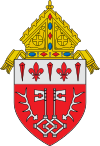Church of Our Saviour, Friend of Children
Church of Our Saviour, Friend of Children | |
 | |
| Location | North Shore Rd., Payment Settlement on Sugar Island, near Sault Ste. Marie, Michigan |
|---|---|
| Coordinates | 46°31′38.66″N 84°9′4.51″W / 46.5274056°N 84.1512528°W |
| Built | 1856-57 |
| Built by | Michael G. Payment |
| NRHP reference No. | 82002831[1] |
| Significant dates | |
| Added to NRHP | July 08, 1982 |
| Designated MSHS | January 19, 1978[2] |
Church of Our Saviour, Friend of Children, also known as Holy Angels Roman Catholic Church, is a church located on North Shore Road on Sugar Island, near Sault Ste. Marie, Michigan. It was designated a Michigan State Historic Site in 1978[2] and listed on the National Register of Historic Places in 1982.[1]
History
[edit]Michael G. Payment was born in Montreal in 1814.[3] In 1827 he moved to Detroit and became involved in business.[3] He soon was put in charge of cargo shipments, in which capacity he traded goods with Native Americans.[3] In 1845, Payment moved to Sugar Island and established a small settlement, known at the time as "Payment's Landing" or "Payment Settlement."[2] Payment undertook trade with the local Ojibwe people, establishing a successful trading post. Beginning in 1853, Bishop Frederic Baraga was a frequent visitor to the settlement, and in 1856 Baraga purchased lumber and requested that Michael Payment construct a church at the site. Payment complied, and the building was completed in 1857.[2]
Michael Payment returned to Detroit in 1874,[3] but regular services were held at the church[4] until it closed in 1953.[2] The church reopened in 1982 for services in the summer.[2] It is the last remaining structure from Payment's Landing.[2]
Description
[edit]Church of Our Saviour, Friend of Children is a single story frame structure sitting on a fieldstone foundation. The exterior was originally clad in clapboard, but at some time weatherboarding was installed over the original siding.[2] The church has a gable roof with a square, pyrimidal-roofed belfry at the top. Each side has three windows, and one end has an entry portico below a plain wooden cross.[2]
See also
[edit]References
[edit]- ^ a b "National Register Information System". National Register of Historic Places. National Park Service. March 13, 2009.
- ^ a b c d e f g h i State of Michigan (2009). "Church of Our Saviour, Friend of Children". Historic Sites Online. Michigan State Housing Development Authority. Archived from the original on May 11, 2012. Retrieved June 26, 2010.
- ^ a b c d Barnard, F. A. (1878). American Biographical History of Eminent and Self-Made Men: Michigan Volume, Part 1. Western Biographical Publishing. p. 112.
- ^ "Sacred Heart, Sugar Island". Diocese of Marquette. Retrieved April 22, 2012.
- Churches in the Roman Catholic Diocese of Marquette
- Churches on the National Register of Historic Places in Michigan
- Roman Catholic churches completed in 1857
- 19th-century Roman Catholic church buildings in the United States
- Churches in Sault Ste. Marie, Michigan
- Michigan State Historic Sites in Chippewa County
- National Register of Historic Places in Chippewa County, Michigan
- 1857 establishments in Michigan
- Wooden churches in Michigan



